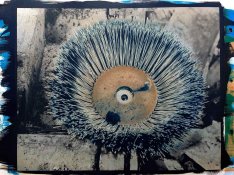tnp651
Subscriber
Bear with me while I play devil's advocate. I've been making kallitypes for about a year and a half, using digital negatives made from scanned 4x5 negatives. It occurs to me that I could make inkjet prints that look as good or better than the kallitypes, with better tonal range and (almost) as much archival permanence. So why do it?
I like being back in the darkroom again. I like the physicality of the process. I like the difficulty of coating the paper, the anticipation of seeing if it turned out. I like the story I can tell my friends of going back to a 19th-century process. But does the print have any more value? If you can't tell it from an inkjet (except, perhaps, with a 10X loupe) does it have more actual value as an art object? Am I like those guys in their woodshops, making and painting little whirligigs and then trying to sell them, when the fun is in the making, not the having?

Am I like the Instagrammers with their filters, pasting Art over my images to give them more pizazz? Much of museum-grade fine-art photography is about the artist's concept, not the image (which can be stunningly mundane). Am I like that, making prints because of the story I can tell, or because the doing of it is fun? Obviously, in any hobby we're doing it for fun, but I want to produce something whose value justifies the extra work.
I'm not just trolling here. This is a real question for me. What do you think about this? Why do you use alternative processes?
Tom
I like being back in the darkroom again. I like the physicality of the process. I like the difficulty of coating the paper, the anticipation of seeing if it turned out. I like the story I can tell my friends of going back to a 19th-century process. But does the print have any more value? If you can't tell it from an inkjet (except, perhaps, with a 10X loupe) does it have more actual value as an art object? Am I like those guys in their woodshops, making and painting little whirligigs and then trying to sell them, when the fun is in the making, not the having?

Am I like the Instagrammers with their filters, pasting Art over my images to give them more pizazz? Much of museum-grade fine-art photography is about the artist's concept, not the image (which can be stunningly mundane). Am I like that, making prints because of the story I can tell, or because the doing of it is fun? Obviously, in any hobby we're doing it for fun, but I want to produce something whose value justifies the extra work.
I'm not just trolling here. This is a real question for me. What do you think about this? Why do you use alternative processes?
Tom




